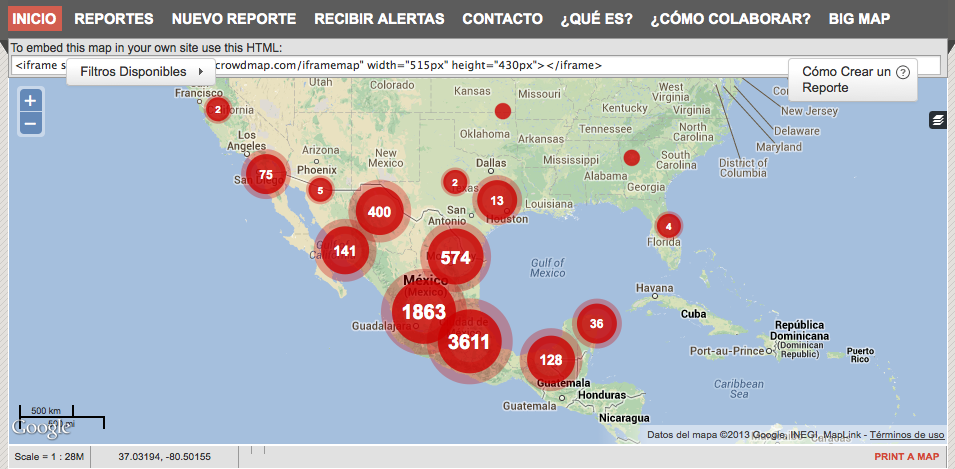
A group of citizens and activists have come together to map the 27,000 people reportedly missing in Mexico on a collaborative map: #PorTodxsLxsDesaparecidxs – “For all the disappeared”.
So far, 6,890 cases have been mapped out of the 27,000 reported missing by the country’s National Human Rights Commission (CNDH) as a result of the military offensive against drug cartels launched by former President Felipe Calderón in 2006.
The official number of people who were reported missing during Calderón’s six-year term stood at 26,121 in February of this year. But according to Manuel Robles, the map’s co-administrator, many disappearances are not being reported and the number of missing persons could be around 30,000 or more.
“While disappearances may have started on Calderón’s watch, they did not end with his term. Thousands of the disappeared are still missing. Soldiers and police are hiding the truth about their fate. And the victims’ families continue to suffer from not knowing what happened to their loved ones,” José Miguel Vivanco, Americas director at Human Rights Watch, said in February of this year.
Manuel Robles explains that to map each case they use a list of missing persons which was released by the Attorney General's Office (PGR), plus lists released by State Attorney offices, and citizen reports. The team behind the map verifies the information they receive from citizen reports, which are at times incomplete.
Incomplete reports are published temporarily, with a note asking the person who sent the report to add the missing information. If there is no response after “a reasonable amount of time”, as Robles explains, the report is removed from the map, but the group keeps the information on their database.

Robles says that since the site was launched in July, citizens have sent in very complete reports. “We are giving citizens the tools to send these reports, and we are being very careful with what we publish to not discredit the quality of information that’s on the map”, Robles emphasizes.
The reports can be filed under different categories. At the time this article was written, 2,589 reports had been filed under “Women and children,” 9 under “Journalists,” 160 under “Forced disappearance,” and 30 under “Found.”
“The ultimate goal [of this map], although we know that it is unrealistic, is that all the missing appear, preferably alive, and that justice is served for all the dead from this pointless war,” says Robles.
However, Robles admits that a more realistic goal would be to force authorities to revise their strategy in fighting organized crime, especially narcotrafficking. “We want [authorities] to do their job. We want the State to guarantee what the laws, and what our constitution, establishes as the duties and obligations of the State: to protect the citizenry. This is not happening”, Robles explains. “If we wanted to make one wish as a result of this work that we are doing with the map of the disappeared, it would be for the state to really meet its duties and obligations.”
Robles is direct in his criticism of the Mexican government’s strategy in the so-called “war” against drug cartels and organized crime: “With this map of the disappeared we are lifting up a rug to show the dirt derived from a flawed State policy.”
Citizens and activists of different backgrounds and professions make up the team behind the map. Mexican blog Nuestra Aparente Rendición [es] praises their work:
A pesar de tener ocupaciones como consultorías o atender a la familia, estos héroes del ciberespacio (algunos anónimos) hacen a un lado problemáticas de su vida cotidiana para dedicarse de lleno a una alerta ciudadana en pos del bien común. Entre los integrantes encontramos a (por su Twitter): @misspartes, @princesabathory, @mroblesmx, @cecy_er, @qual36 y Alberto Escoria de @YoSoyRed, quienes se reparten el trabajo que requiere administrar, depurar y cotejar la base de datos de los desaparecidos
Despite having occupations like consulting or caring for their family, these heroes of cyberspace (some anonymous) put their everyday life problems to the side to devote themselves to a citizen initiative in pursuit of the common good. Among the members we find (by their Twitter username): @misspartes, @princesabathory, @mroblesmx, @cecy_er, @qual36 and Alberto Escoria of @YoSoyRed, who split the work required to manage, organize, and assemble this database of the disappeared.
On Twitter the group is using the hashtag #PorTodxsLxsDesaparecidxs to promote the map and to invite other citizens to contribute their reports.
When asked about the final objective of this map, Manuel Robles concludes: “We know that our work is just a grain of sand in the beach that we have to build in order for this to change. This doesn’t discourage us. We know that this has to be done, and we know that someone has to do it. We don’t know if we will create change with our efforts, but we want Mexico to be a country governed by the rule of law, a rule of law that today does not exist.”




1 comment